Blog


Genealogy Gems Podcast Episode 242 – Genealogy Research Questions
Podcast host: Lisa Louise Cooke
June 2020
In this episode we discuss how great genealogy questions and research plans can help you accomplish your family history goals. Then I’ve got ideas you can start using right away to manage distractions effectively.
Watch Elevenses with Lisa live on the Genealogy Gems YouTube channel on Thursdays at 11:00 AM Central. After the live show you can watch the video replay at your convenience. You’ll find the show notes for Elevenses with Lisa here on the Genealogy Gems website.
Research Plans and BSOs
On March 26, 2020 I started producing a new weekly YouTube Live show called Elevenses with Lisa. Originally it was in response to the fact that COVID-19 had created a situation where we were all staying home. For me that meant that all of my in-person speaking engagements for the foreseeable future had been cancelled or rescheduled. I saw it as an opportunity to take on a new challenge, which is live video production.
I love doing the live show on YouTube. It’s definitely different than doing a podcast. It’s more interactive which in turn makes me more animated. And obviously it’s a visual medium so it provides an opportunity to show as well as tell.
Of course, sitting down to watch a video is more stagnant than listening to a podcast. When you’re listening to a podcast you can still move about and get things done if you want. So, I’m sure there are some of you who haven’t seen the Elevenses with Lisa show yet. That’s why in this episode I’m bringing you a few highlights of the YouTube Live show in audio form.
In episode 2 of Elevenses with Lisa I talked about the importance of creating research questions and plans. This was the first presentation in a series called How Alice the Genealogist Avoids Falling Down the Rabbit Hole. If you want to stay on track and achieve your genealogy goals, a research plan is really essential.
Then in the third episode I talked about “Bright Shiny Objects”, also known as BSOs, that can distract you from your research plan. I shared the techniques I use to deal with them so that I don’t miss a good thing while still staying on track.
If you watch the show this will be a refresher for you, and if you haven’t gotten around to watching it, I hope it will inspire you to join us in the future, as well as help you improve your genealogy research today.
You will find the complete notes for the topics discussed in this episode (and more) in the show notes web pages for these episodes of Elevenses with Lisa:
Episode 2 – how research questions and plans will improve your genealogy research.
Episode 3 – dealing with Bright Shiny Objects that threaten to get you off track.
Get the Entire “Alice” Video and Handout
If you enjoyed this portion of How Alice the Genealogist Avoids the Rabbit Hole and you’re a Genealogy Gems Premium member, I have the entire presentation edited together in one complete video class for you in the Premium Videos area at genealogygems.com.
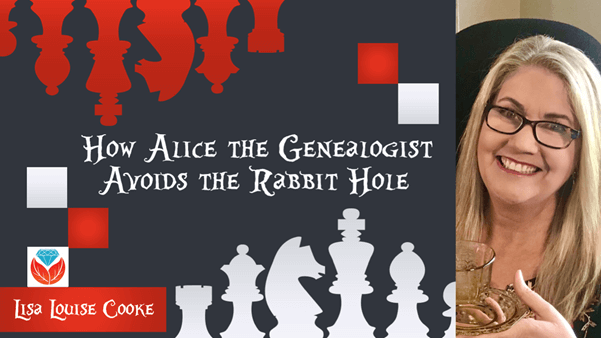
Premium Members get the entire video class plus 7 page downloadable handout.
There you can also download the complete handout which is ad-free and 7 pages long. It includes not only research plans and BSO management but also creating supportive research environments both on your computer and mobile devices.
Become a member here.
GEM: June Weddings
Monday, June 15.
For centuries, the month of June has been the most popular choice for weddings.
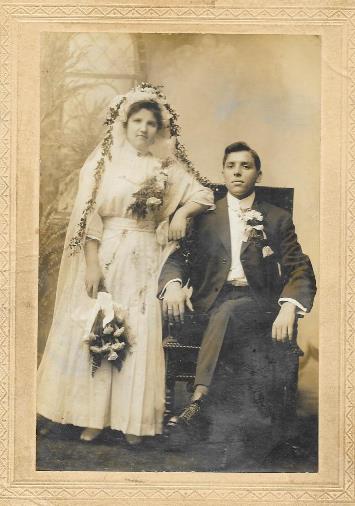
All about June Weddings – Genealogy Gems
One of the purported reasons was that some hundreds of years ago, this time was just after May’s annual bath, so the happy couple and the guests were about as clean as could be hoped.
With the ensuing advances in plumbing and overall hygiene, dressy weddings are readily staged year-round, from simple civil ceremonies and backyard or back-to-nature vows, to elaborate church functions. In normal years, there are more than 2.2 million weddings across the nation.
The median age at first marriage for women is now 28 years— up six years since 1980. Men are now an average age of 29.8 when they take their first vows.
Sources:
June weddings, accessed 2/3/2020
Number of marriages, accessed 2/3/2020
Getting Your History Digitized
Our family’s history comes in many forms, and some of them over time can become obsolete. I shared in this episode my continuing progress on my own project of converting the rest of my old home movies that are in a variety of formats (8mm, mini DV, High 8, and VHS.) I use Larsen Digital and have been extremely pleased with the service and results. The folks at Larsen Digital have put together special and exclusive discounts for Genealogy Gems listeners and readers. Click here to learn more and receive exclusive discounts and coupon codes.
Read more: 5 Steps to Digitizing Your Old Negatives

Learn how to tackle the task of digitizing your old negatives at Genealogy Gems
Get the Genealogy Gems Podcast App
Get the right app for your phone or tablet here.
Follow Lisa and Genealogy Gems on Social Media:
Instagram.com/genealogygemspodcast
Facebook.com/genealogygems
Pinterest.com/lisalouisecooke
YouTube.com/GenealogyGems

follow Lisa Louise Cooke on Instagram
Get the Free Genealogy Gems Newsletter
The Genealogy Gems email newsletter is the best way to stay informed about what’s available with your Premium eLearning Membership. Click here to sign up today.
Download the Show Notes

How to Get Relatives Interested in Family History – Episode 11 (Elevenses with Lisa)
Live show air date: June 4, 2020
Episode 11 Video and Show Notes
Join me for Elevenses with Lisa, the online video series where we take a break, visit and learn.
Today’s Teacup
Chatsworth is home to the Duke and Duchess of Devonshire, and has been passed down through 16 generations of the Cavendish family. The movie Pride and Prejudice (2005) was filmed there. In my cup: Blueberry Merlot by Tea Forte Herbal Retreat. You can get it here at Amazon (This is an affiliate link, so if you make a purchase we will be compensated at no additional cost to you. Thank you for supporting this free show!)
How to Get Relatives Interested in Family History
For me Family and faith have always been the answer for life’s challenges and turmoil. In this hour together we will recharge and look at ways to positively influence our family, now and in the future.
Preparing Your Relatives Now
Focus on ways to make the results of your research understandable by non-genealogists and create those items now. Make it a priority to share your findings in creative and simple ways as you go to help relatives understand the value of your research to you and them. You will have much more success down the road if you help build understanding today.
Sharing Ideas
Christmas Wreath and Crazy Quilt Christmas Stocking
Click here for the Genealogy Gems playlist that includes the 4 part instructional series on making these family history wreaths.
Crazy quilt a stocking and add transferred photos of your ancestors using T-shirt transfer paper.

Crazy quilt a stocking and add transferred photos of your ancestors.
Repurpose or upcycle items you already have
I turned an unfinished crocheted heirloom tablecloth into a vest for my daughter.

I upcycled an old unfinished crocheted tablecloth into a vest
Genealogy Wall Charts
You can order genealogy wall charts through websites such as MyHeritage or Ancestry.
Here’s a free fan chart from FamilySearch.
See all your options by Googling genealogy wall charts.
Embellished Picture Frames
Decorate an old picture frame with items reflecting the life of your ancestor featured in the photo.

Embellish an old photo frame with vintage items that help tell the story of your ancestor.
Family History Wall Art
Make wall art like the matte canvas photo I made in episode 6 of Elevenses with Lisa. The show notes for that episode includes details.
Posters from Family Photos
Get posters made of significant photos from the past. I ordered mine from Vista Print. If you sign up for a service’s newsletter you’ll likely get notification of sales and discount coupons. Poster frames can be ordered online through Amazon and stores like Michael’s or Hobby Lobby.

Celebrate the history of your family members!
Tabletop Family Story Displays
I took an old locker and filled it with items reflecting my husband’s story. You could also use a small cabinet, crate, basket, etc.
Coffee Table Books that Tell Your Family’s Story
- www.shutterfly.com (where I made my books)
- Lulu Press
- MyCanvas (Ancestry)
In episode 206 of the Genealogy Gems Podcast I talk about how I made the book about my grandmother’s 50-year nursing career.
Genealogy Gems Premium Members can listen to the Premium Podcast Episodes 52-54 which feature a 3-part series on publishing your family history.

Create short books that tell a single family history story.
Google Earth “Family History Tour”
Back in 2009 I pioneered a use for the free Google Earth program called “Family History Tours”. These tours take a little time but are fairly easy to create, and they make a big impact. You can download Google Earth Pro for free here. Then, watch my video below for a closer look at family history tours in Google Earth.
Resources for learning how to create family history tours:
- Google Earth for Genealogy step-by-step tutorial video series by Lisa Louise Cooke.
- The Genealogist’s Google Toolbox (book)
Both available at the Genealogy Gems Store here.

Over 2 1/2 hours of easy-to-follow instructions by Lisa Louise Cooke.
Get More Ideas at Pinterest
Check out my genealogy Pinterest boards here.

Follow me on Pinterest.
Family History Blog
Sharing your family history information on a blog gives you an easy way to cross-post on social media as well as be found by others how are Googling to find information on the same family lines.
Start a free blog at www.blogger.com. Watch my free instructional video series on how to set up your free blog at the Genealogy Gems YouTube channel.
Turn Family History Photos into Eye-Catching Memes
I use the Retype app. (About $2.99)
Other free alternatives include apps like Adobe Spark Post or Over.
Add text to photos, customize the font and text color, and save. An easy way to access old family photos on your smartphone or tablet is to save copies of the photos to a free cloud service on your computer. Then open that app on your phone. Select a photo and save it to your device. Once the photo is in your Photos app, you can then open Retype and import that photo. Add text, font, color and more.
Get more complete instructions and other mobile computing ideas like this from the book Mobile Genealogy: How to Use Your Smartphone or Tablet for Family History.

Apps can turn family history photos into social media image that generate conversation.
Create a Video that Tells a Story
It’s easier than ever to create videos, and no special skills are required. Video is the #1 type of content on the Web and with the next generation. Get instructions and ideas here at Genealogy Gems.
I trust all of my old home movies (8mm, VHS, mini DV, High-8, etc.) conversion and digitization to Larsen Digital. They do spectacular work! Click here for exclusive special discounts for Elevenses with Lisa fans!
The video below features one of my grandmother’s old home movies that Larsen Digital converted for me. And boy oh boy was I excited by what I discovered!
From You
Elevenses with Lisa viewer Jillian T. shared how she is bringing family history into her home office:
“I have tried to tune in each week to your Genealogy Gems ‘Elevenses’ (which is 5 pm here in Ireland and therefore a perfect end to my workday). A few weeks ago, you shared how you found the photo of your husbands ancestors and through newspapers found out more about the musical troupe. You organized to have the photo printed on canvas and the finished project was wonderful.
I have always wishing to do a ‘family tree’ on the wall of my office but was afraid it would end up looking like an arts and crafts project. You gave me the kick I needed and decided, if not now, when?
So, I measured up the wall, researched and trawled through my vast collection of photos. I was very conscious that I have better historic photos on my ‘dads’ side with thanks to a wonderful elderly cousin who shares my passion. But as a genealogist, I wished to ensure I had balance and so decided only three photos from each ‘side’. I found a decal that was a good price (about $20) and the perfect size for my wall. I organised for the photos to be printed and mounted on canvas (more expensive but knew if the project didn’t work, I could find another use for the mounted photos).
It took a few weeks for everything to arrive, as you will see in the attached, I did the base of the tree first – we called it the haunted tree as we had to wait another week for the photos to arrive. Then we took time deciding on the placing of the photos and then added the leaves.
I am writing to say a huge thank you. I will have this lovely project to remind me of this time, and as I sit here and type, it is lovely to know my family ‘has my back’.
Thank you for your initiative of the weekly meet up. Your energy and enthusiasm are infectious. I met you at RootsTech in 2016 and have continued to follow you since. Thank you for all you do and to you and your family, let me share an old Irish blessing “May the road rise up to meet you. May the wind always be at your back. May the sun shine warm upon your face, and rains fall soft upon your fields.
Warmest wishes, Stay smart, Jillian”

Jillian’s ancestors “have her bacK” in her office!
Gayle P. shares some of the ways she protects her family history from destruction.
“I have organized many things into books. My living room is my grandma’s family history room and some of my grandchildren love to look through things. However, when I ask if they would be interested in having certain books, they ask me, “Grama, why don’t you scan it and give me a flash drive or CD.” I decided to give memory flash drives for Christmas presents. I feel relieved that I have several backups.
For example, while my son was serving a two-year mission in Germany, 1990-1992, he wrote faithfully every week. 30 years later, he is now working for the Air Force in Germany close to where he served his mission.
I scanned his letters and pictures he sent to me, organized them in books and sent them to him. His children enjoy the scanned version of his memoirs. He plans on revisiting many of the areas where he served 30 years ago. He wrote four simple words that brought many tears: “Mom, thank you forever.”
Another example is I have scanned and organized my pictures by years and share many of these years with my family. Over Memorial Day, my daughter-in-law was in a panic because she could not retrieve her 2012 pictures. She called and asked if I could share my 2012 pictures. Within a short time, I was able to scan about 5000 pictures I had for that year and share with her. I had many, many pictures of her daughter and her family. Another “thank you forever” brought tears to my eyes.
I currently have over 500,000 pictures/documents scanned and have three personal backups. I am still have a lot to scan and probably will not get everything scanned before I die, but I am sharing what I have now so I know that some of my family will have a copy of my most treasured work and memories.
Scanning and sharing a ton in Idaho, Gayle”
Now there’s a woman who doesn’t need a “round tuit”, and who is definitely a positive influence on her family!
Cathy G wrote a comment to ask about the templates I use for my notebook covers and spines.
“Wonderful shows – really enjoying the elevenses. Such good information always. Especially enjoyed the ones on organizing paper and hard drive database. More please. One quick question: you mentioned printing your own binder covers and spines – can’t find a template in my Word program. Can you direct us to the one you use? Thanks.”
I’m happy to share my simple yet effective templates for the covers and spines on my notebooks. Genealogy Gems Premium members can now download these from the Resources section of the Elevenses with Lisa episode 6 show notes.

Gayle has been hard at work creating family history notebooks.
Watch My Free Presentation
Watch my free Facebook Live presentation of Fabulous Photo Discoveries at MyHeritage.
It’s all about finding and colorizing your old family photos. The video replay is available here at the MyHeritage Facebook page.
Final Thoughts on Passing on Our Genealogy
I hope you enjoyed the ideas presented in this episode, and that you take action on at least one of them. It may be just what your relatives need to see the family history clearer.
That being said, even if no one else in your family cares right now or wants your genealogy, It’s ok. We’ve done all we can and the rest is out of our control.
If genealogy has brought You joy, sharpened your mind, given you countless hours of amusement, connection, and satisfaction, then it’s all been worth it! No one can take that away from you.
And the way I look at it, when we get to heaven we’ll know a lot more people!
Next Episode of Elevenses with Lisa
Episode 12 will air Live on June 18, 2020 at the Genealogy Gems YouTube channel. After the live show, the episode will be available as a video. Show notes will be published on June 19.
Click the video above to Set your reminder for episode 12, or click here. Please be sure to click our channel’s Subscribe button while you’re there. Then click the Notifications bell to so you’ll know when we post new videos and episodes.
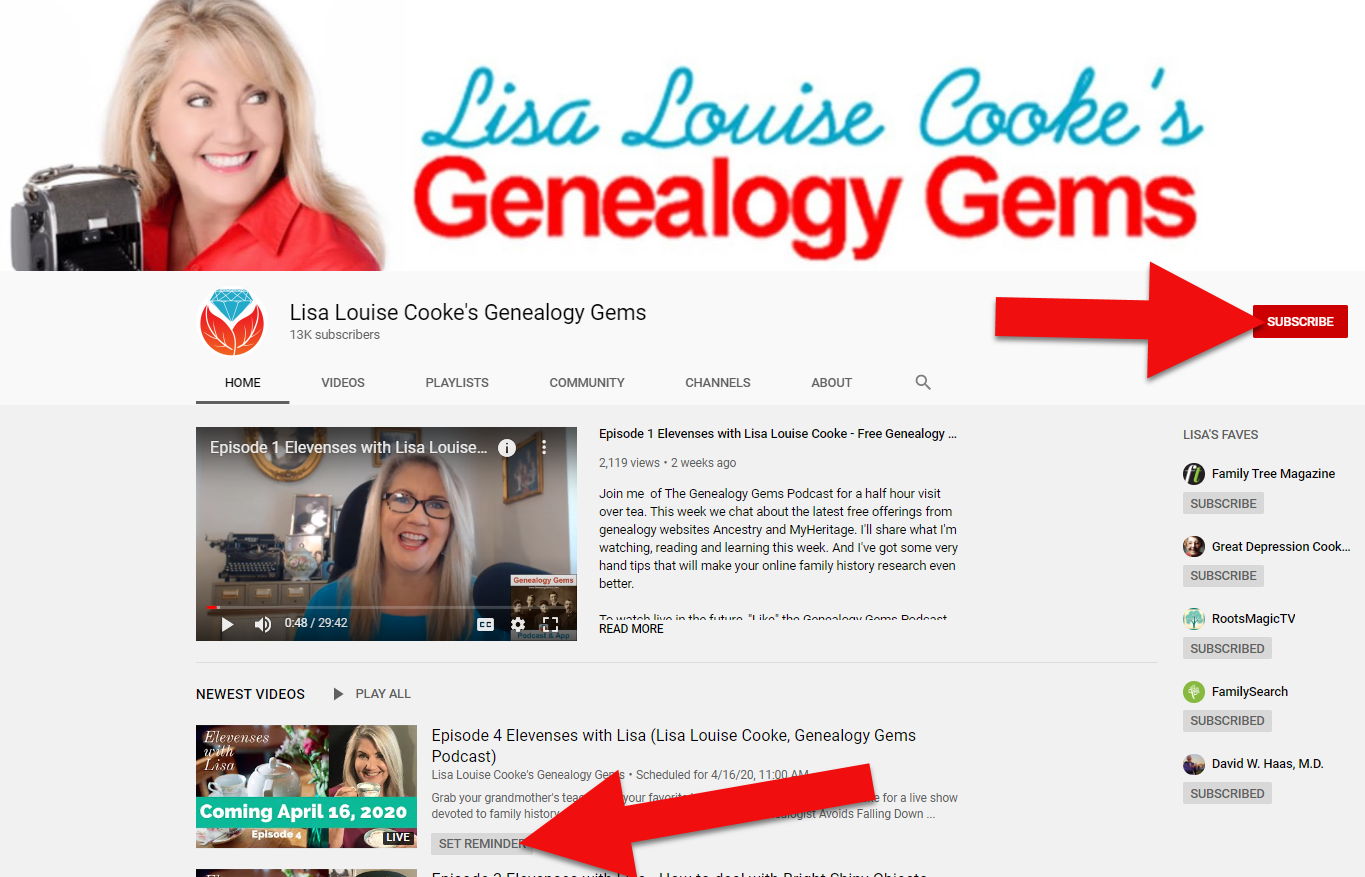
Subscribe and watch at the Genealogy Gems YouTube channel
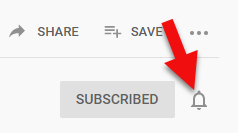
Click the bell too!
Stay smart and stay brave! Thanks so much for watching friend. I’ll talk to you soon.
Will you please do me a favor and take this quick 3 question survey about the show? Thanks!
Resources (Premium Members):
Click here to download the show notes PDF for this episode. (Log in required.)
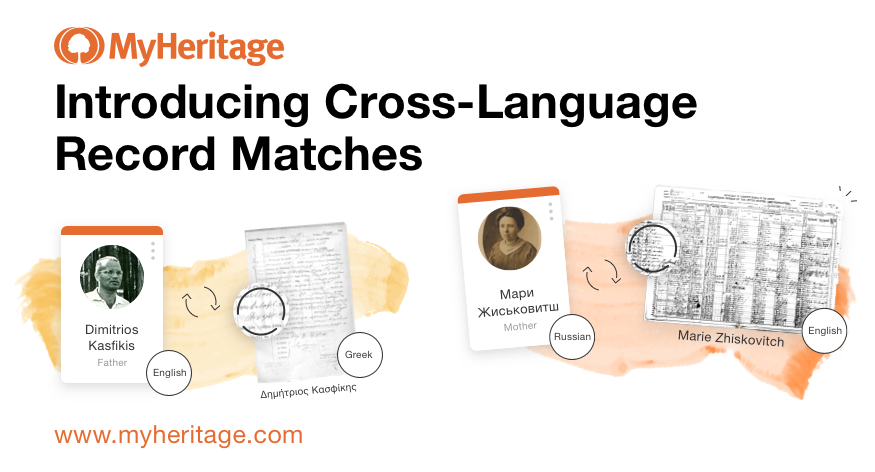
Cross-Language Record Matching Announced by MyHeritage
Here’s the latest news from MyHeritage:
As many genealogists already know, MyHeritage is the website of choice for international genealogy, particularly in Europe. It is also extremely useful for U.S. genealogists whose ancestors arrived in the U.S. from other countries. This strength comes from the fact that MyHeritage is translated into 42 languages and is the most popular genealogy website in most non-English speaking countries, as well as having millions of international users who built family trees found only on MyHeritage, exclusive global record collections, and unique technology for overcoming language barriers.
We are working constantly to improve the technologies on MyHeritage even further and today, we’re delighted to announce a significant innovation: our Global Name Translation Technology™ has been extended to apply to Record Matches as well!

Individuals researching their heritage often face a language barrier when researching their ancestors who lived in another country. MyHeritage pioneered Global Name Translation Technology™ to help users overcome this barrier, by automatically translating names between languages. This unique capability, originally conceived by MyHeritage’s Founder and CEO, allows users to locate records that mention their ancestors in different and often unexpected languages (as well as in synonyms in each language). Initially, this was available in our search engine, SuperSearch™, and has now been extended to automatic Record Matches as well.
For example, if you search for an ancestor you know as Alexander, the algorithm may uncover a Spanish record where his name is listed as Alejandro (a Spanish version of Alexander), or a Russian record with the name written Александр in Cyrillic characters (the Russian way to write Alexander), or its common Russian nickname Саша (Sasha).
With this new addition, translated Record Matches are now calculated on an ongoing basis, and you’ll receive matches with historical records and family tree profiles in other languages.
When you view them, the names will be conveniently spelled out using your own alphabet. You may already have noticed some records from other languages appearing in your matches.
This feature will help you easily locate records that would otherwise have been very difficult for you to find.
This unique technology is only available on MyHeritage and works hand in hand with our huge database of international records.
